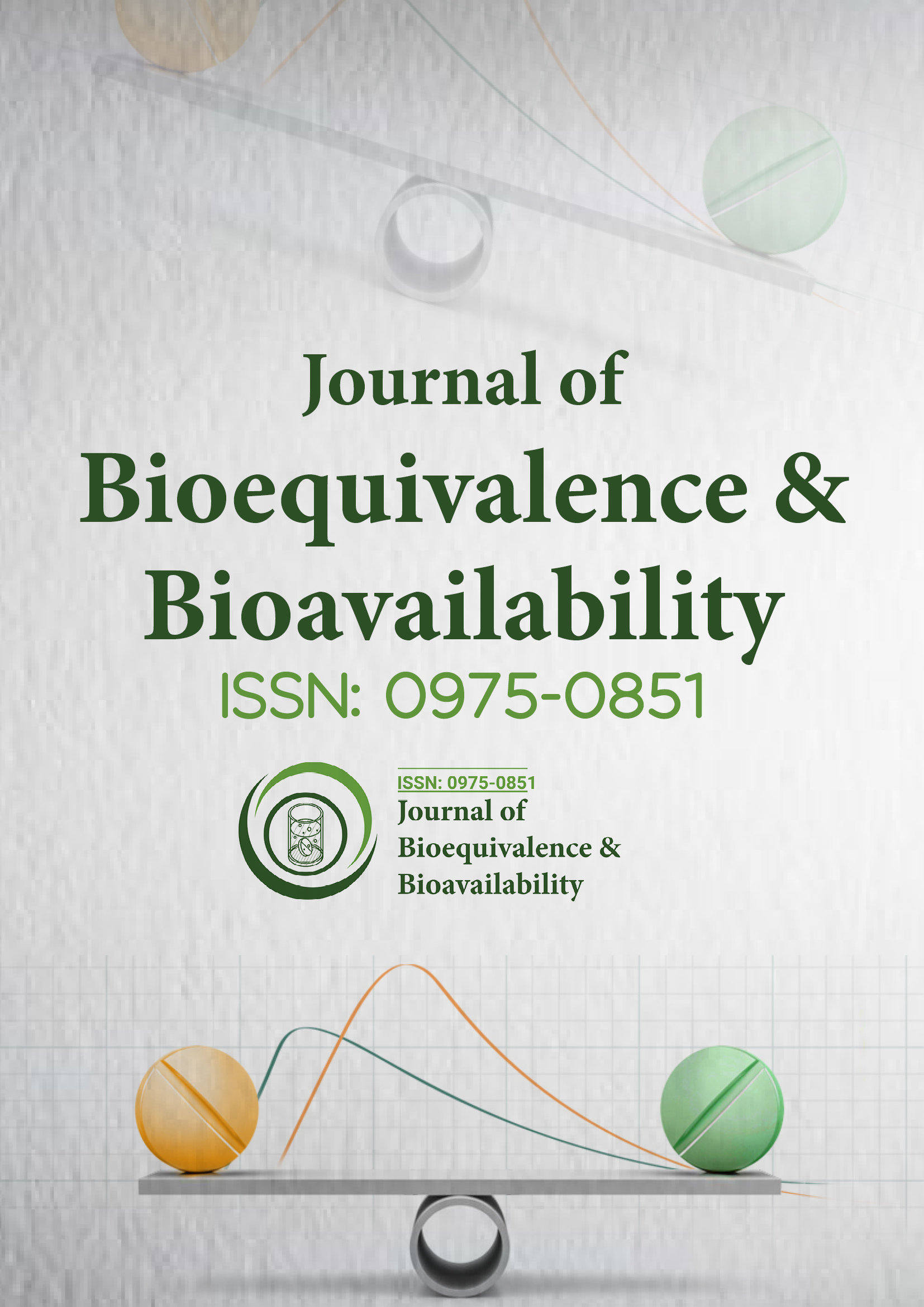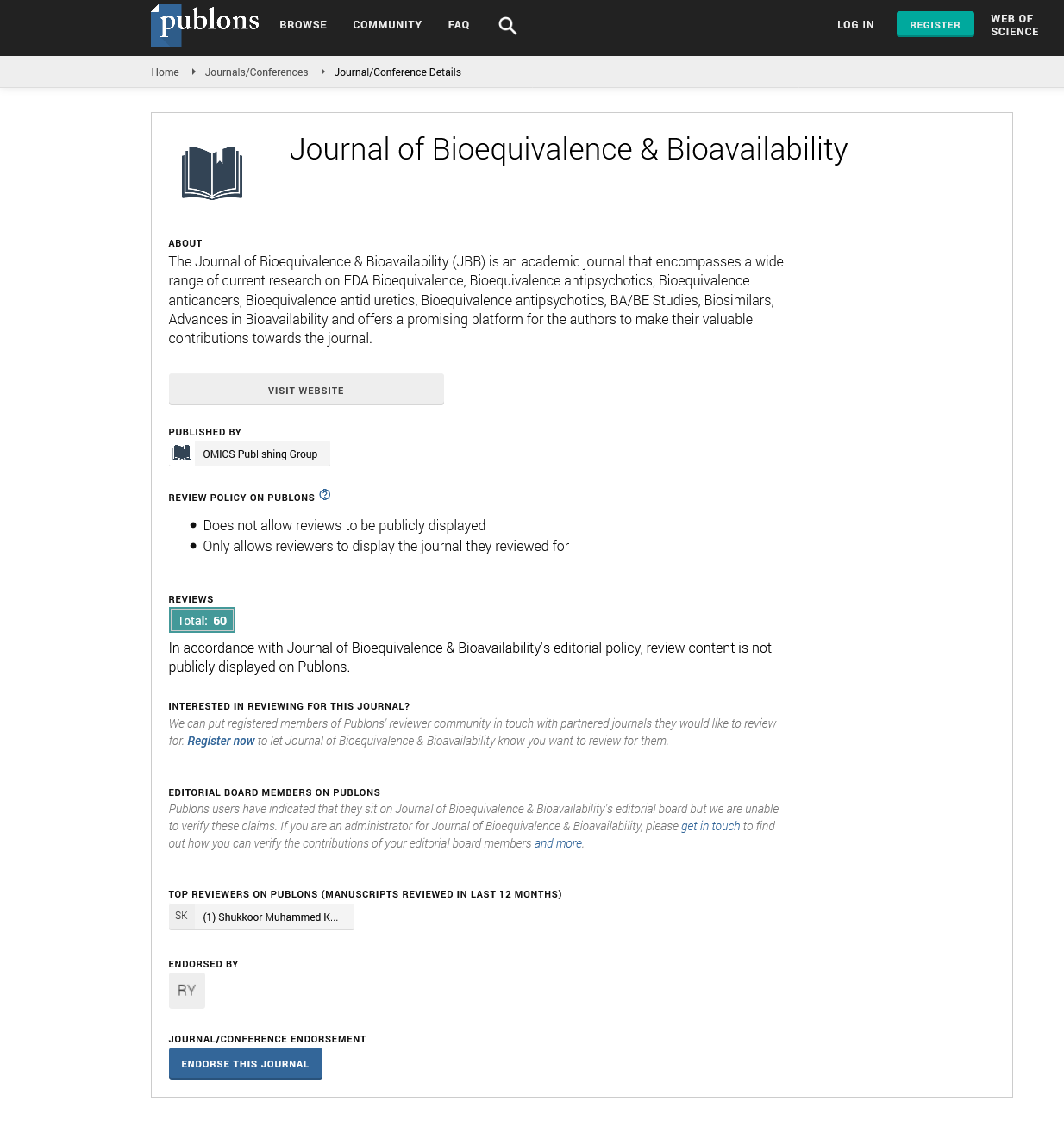Indexed In
- Academic Journals Database
- Open J Gate
- Genamics JournalSeek
- Academic Keys
- JournalTOCs
- China National Knowledge Infrastructure (CNKI)
- CiteFactor
- Scimago
- Ulrich's Periodicals Directory
- Electronic Journals Library
- RefSeek
- Hamdard University
- EBSCO A-Z
- OCLC- WorldCat
- SWB online catalog
- Virtual Library of Biology (vifabio)
- Publons
- MIAR
- University Grants Commission
- Geneva Foundation for Medical Education and Research
- Euro Pub
- Google Scholar
Useful Links
Share This Page
Journal Flyer

Open Access Journals
- Agri and Aquaculture
- Biochemistry
- Bioinformatics & Systems Biology
- Business & Management
- Chemistry
- Clinical Sciences
- Engineering
- Food & Nutrition
- General Science
- Genetics & Molecular Biology
- Immunology & Microbiology
- Medical Sciences
- Neuroscience & Psychology
- Nursing & Health Care
- Pharmaceutical Sciences
Perspective - (2025) Volume 17, Issue 2
Clinical Trial Simulation for Bioequivalence Prediction in Complex Anticancer Therapies
Received: 03-Apr-2025, Manuscript No. JBB-24-28977; Editor assigned: 07-Apr-2025, Pre QC No. JBB-24- 28977 (PQ); Reviewed: 21-Apr-2025, QC No. JBB-24- 28977; Revised: 28-Apr-2025, Manuscript No. JBB-24- 28977 (R); Published: 05-May-2025, DOI: 10.35248/0975-0851.25.17.629
Description
Bioequivalence in the realm of anticancer drugs presents a complex and high-stakes challenge. Given the narrow therapeutic index and the critical nature of oncology treatments, ensuring that generic anticancer medications are bioequivalent to their branded counterparts is both a scientific imperative and an ethical responsibility. While the core principles of bioequivalence remain unchanged, the pharmacological characteristics of anticancer agents demand a more nuanced and often more rigorous approach.
Unlike conventional drugs, many anticancer agents have a very small margin between therapeutic and toxic doses. Even minor deviations in bioavailability can lead to subtherapeutic exposure or increased toxicity, compromising treatment efficacy or patient safety. This has led regulatory agencies worldwide to adopt stringent criteria for bioequivalence in oncology drugs, especially those administered orally or with high variability in pharmacokinetics.
One of the main hurdles in demonstrating bioequivalence for anticancer drugs is the complexity of their pharmacodynamics. Many such agents act on multiple targets, exhibit non-linear kinetics, or require metabolic activation. These features make it challenging to select appropriate surrogate markers, such as Cmax and AUC, that accurately predict clinical performance. As a result, additional endpoints such as pharmacodynamic biomarkers, tumor response rates, or even clinical endpoints may be needed in some cases.
Moreover, anticancer drugs are frequently used in combination regimens, where interactions with other agents can alter their bioavailability and efficacy. Studying a single drug in isolation during bioequivalence trials may not capture the full therapeutic context. To mitigate this, advanced modeling and simulation techniques are being employed to predict how generics will behave in real-world polypharmacy scenarios.
Nanomedicine-based anticancer formulations pose another layer of complexity. Liposomal doxorubicin, albumin-bound paclitaxel, and other nanoparticle-based systems cannot be evaluated using standard bioequivalence metrics alone. Their pharmacokinetics are influenced by factors such as particle size, surface charge, and encapsulation efficiency, all of which can affect distribution, clearance, and targeting. Regulatory bodies now often require comparative physicochemical characterization, in vitro release testing, and in vivo biodistribution studies for such products.
In certain cases, In Vitro-In Vivo Correlation (IVIVC) models are utilized to bridge formulation properties with expected clinical performance. However, establishing IVIVC for anticancer drugs is fraught with challenges, given the heterogeneity of tumors, patient variability, and the unpredictable nature of cancer biology. To overcome these barriers, multi-tiered assessment strategies are gaining traction, combining bioanalytical assays, modeling, and limited clinical trials.
Furthermore, patient populations for anticancer treatments are often immunocompromised or vulnerable, necessitating a cautious approach to trial design. Ethical considerations limit the use of healthy volunteers, leading to reliance on patient-based studies. This not only complicates recruitment but also introduces variability due to disease progression, co-medications, and organ dysfunction, which must be accounted for in study design and data interpretation.
There is also a growing emphasis on post-marketing surveillance and real-world evidence to support bioequivalence claims for anticancer generics. Regulatory authorities increasingly demand robust pharmacovigilance programs and registries to track outcomes and adverse events once generics are introduced to the market. These data help validate the initial bioequivalence findings and provide reassurance to oncologists and patients.
In many low- and middle-income countries, access to generic anticancer drugs is vital for expanding treatment coverage. Demonstrating bioequivalence not only enables cost savings but also empowers healthcare systems to provide life-saving therapies to broader populations. However, the burden of ensuring quality and therapeutic equivalence remains high, necessitating strong regulatory frameworks and international collaboration.
In conclusion, while the principles of bioequivalence apply universally, their application in the context of anticancer drugs demands heightened scientific rigor, tailored methodologies, and continuous post-approval monitoring. As oncology continues to advance, with targeted therapies and personalized medicine at the forefront, the evaluation of bioequivalence must also evolve embracing innovation while upholding the highest standards of patient safety and therapeutic integrity.
Citation: Shen Y (2025). Clinical Trial Simulation for Bioequivalence Prediction in Complex Anticancer Therapies. J Bioequiv Availab. 17:629.
Copyright: © 2025 Shen Y. This is an open-access article distributed under the terms of the Creative Commons Attribution License, which permits unrestricted use, distribution, and reproduction in any medium, provided the original author and source are credited.

